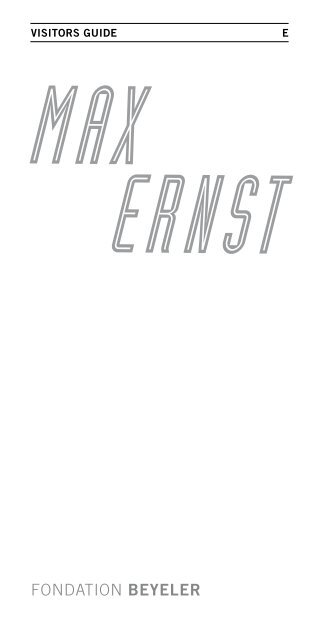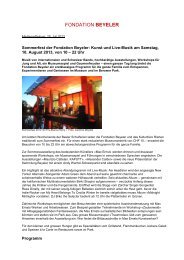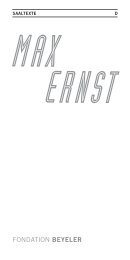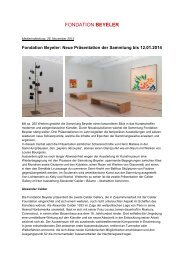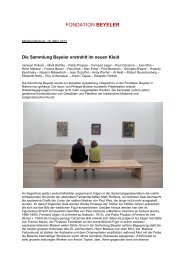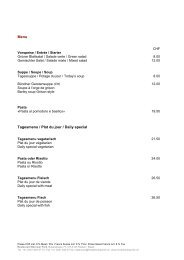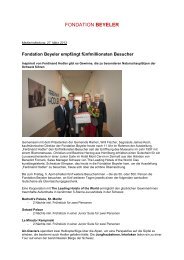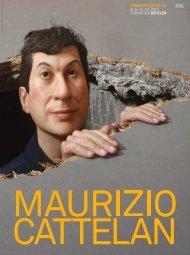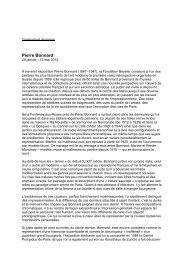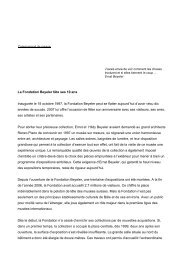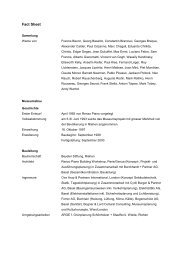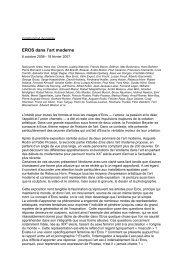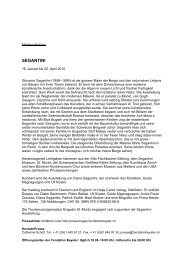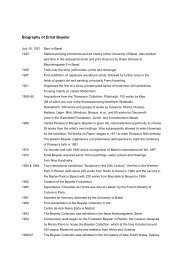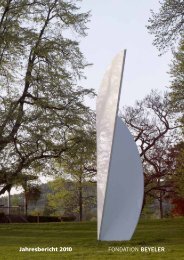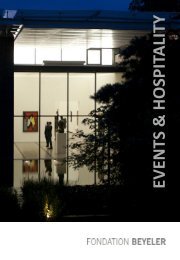Visitors Quide "Max Ernst" PDF (351 KB) - Fondation Beyeler
Visitors Quide "Max Ernst" PDF (351 KB) - Fondation Beyeler
Visitors Quide "Max Ernst" PDF (351 KB) - Fondation Beyeler
You also want an ePaper? Increase the reach of your titles
YUMPU automatically turns print PDFs into web optimized ePapers that Google loves.
VISITORS GUIDE E<br />
FONDATION BEYELER
MAX ERNST<br />
26 May – 8 September 2013<br />
Whenever this symbol appears on the information panel<br />
accompanying an exhibit, it means you will find the work of<br />
art discussed in detail under the corresponding number in<br />
this <strong>Visitors</strong> Guide.<br />
CAUTION: Please do not touch the works of art!<br />
2
TABLE OF CONTENTS<br />
Introduction 4<br />
FOYER 5<br />
ROOM 1 6<br />
ROOM 2 7<br />
ROOM 3 8<br />
ROOM 4 8<br />
ROOM 5 10<br />
ROOM 6 12<br />
ROOM 7 13<br />
ROOM 8 15<br />
ROOM 9 16<br />
ROOM 10 18<br />
ROOM 11 20<br />
ROOM 12 22<br />
Information / Catalogue 23<br />
Room Plan 24<br />
Peter Schamoni’s documentary film<br />
<strong>Max</strong> Ernst. Mein Vagabundieren – Meine Unruhe<br />
will be showing in the Winter Garden during the exhibition.<br />
3
INTRODUCTION<br />
<strong>Max</strong> Ernst<br />
<strong>Max</strong> Ernst (1891–1976) was one of modernism’s most versatile<br />
artists. After starting out as a rebellious Dadaist in Cologne, in<br />
1922 he moved to Paris and soon became one of the leading<br />
lights of Surrealism. In 1941, he escaped to the USA, where<br />
he provided inspiration for the generation of young American<br />
artists. Returning to war-devastated Europe a decade later,<br />
<strong>Max</strong> Ernst found himself back in relative obscurity, before<br />
being rediscovered as one of the most fascinating artists of the<br />
20th century.<br />
A continual inventor of innovative figures, forms, and techniques,<br />
such as collage, frottage, grattage, decalcomania, and<br />
oscillation, <strong>Max</strong> Ernst was constantly turning his attention in<br />
new directions. The result was a unique body of works that<br />
resists any clear stylistic definition. The artist’s eventful life and<br />
changing abodes in Europe and America were crucial shaping<br />
factors in the development of his oeuvre. Full of enigma and<br />
contradiction, his pictures seem to have arisen out of (nightmarish)<br />
dreams in which surreal landscapes are populated by<br />
strange, disturbing, and erotic figures.<br />
Comprising an outstanding selection of over 160 paintings,<br />
collages, drawings, sculptures, and prints, the extensive <strong>Max</strong><br />
Ernst retrospective at the <strong>Fondation</strong> <strong>Beyeler</strong> presents every<br />
phase of the artist’s career. For the first time in Switzerland<br />
since Ernst’s death, visitors have the opportunity to experience<br />
the multi-facetted oeuvre of this seminal artist in all its rich<br />
diversity.<br />
The exhibition was conceived by guest curators Werner Spies<br />
and Julia Drost and organized in collaboration with the<br />
Albertina in Vienna. The exhibition at the <strong>Fondation</strong> <strong>Beyeler</strong> is<br />
curated by Raphaël Bouvier.<br />
4
FOYER<br />
1 • Capricorne, 1962/1964<br />
Capricorn<br />
Capricorn is a work open to many interpretations, a majestic<br />
‘family seat’ comprising a bull seated on his throne, a nix-like<br />
female companion standing beside him, and a small creature<br />
perched on its father’s massive lap. <strong>Max</strong> Ernst has drawn<br />
upon archaic imagery for this sculpture: in Greek mythology,<br />
Aigokeros (Latin: Capricornus) is a hybrid being who was half<br />
goat, half fish. He aided Zeus in the battle against the Titans<br />
and was rewarded with a place in the heavens as the zodiacal<br />
sign of Capricorn. Surrealism took up such mythical beings<br />
with interest and gave them new life.<br />
<strong>Max</strong> Ernst created the first version of this work—his largest<br />
free-standing sculpture—in 1948, while living in exile in<br />
America. Having fled Europe in 1941, Ernst and his wife, the<br />
paintress Dorothea Tanning, withdrew to the wild, desert landscape<br />
of Arizona. They built themselves a small house in a<br />
secluded spot named Capricorn Hill. Capricorn stood sentinel<br />
outside their new home like a cosmic guard.<br />
The massive bronze version in the <strong>Fondation</strong> <strong>Beyeler</strong> foyer is<br />
today here to welcome visitors as they embark on their fascinating<br />
tour through <strong>Max</strong> Ernst’s pictorial cosmos.<br />
5
ROOM 1<br />
2 • Stadt mit Tieren, 1919<br />
City with Animals<br />
<strong>Max</strong> Ernst was 28 years old when he produced this painting<br />
and had only recently come home following the end of the<br />
First World War. He experienced his return from the war as<br />
a rebirth. Talking about himself in the third person, he wrote:<br />
“<strong>Max</strong> Ernst died on 1 August 1914. He was resurrected on 11<br />
November 1918 as a young man who wanted to be a magician<br />
and find the myth of his time.”<br />
In City with Animals, <strong>Max</strong> Ernst portrays a deceptive idyll.<br />
Three animals are resting peacefully before a city whose colorful<br />
houses are threatening to collapse. The city’s inhabitants<br />
are behaving mysteriously: on the left of the picture, a man<br />
wearing a black hat is waving into empty space. To his right, a<br />
woman in a white dress moves as if sleepwalking. Above her<br />
dangles a pulley without a rope, suggesting a gallows and a<br />
hanging. The mood is oppressive. The three animals in the foreground,<br />
with their large, melancholy eyes, seem almost human<br />
and recall the imagery of the Russian painter Marc Chagall.<br />
3 • Oedipus Rex, 1922<br />
<strong>Max</strong> Ernst’s creativity was sparked by a wealth of different<br />
sources: natural phenomena and technical inventions, myth<br />
and his own inner life, the cosmic and the intimate alike.<br />
Oedipus Rex can be considered a programmatic work in which<br />
the artist has channeled the richness of his abundant imagination<br />
into a multi-layered whole. It arose out of Ernst’s intense<br />
preoccupation, around 1922, with the theories of Sigmund<br />
Freud, the subject of dreams, mythology, and the surreal. The<br />
title is an allusion to the story of Oedipus, which tells of patricide<br />
and the fateful love between mother and son.<br />
A large hand protruding out through a window opening is<br />
holding a walnut, which is pierced—like the thumb and index<br />
finger holding it—by a metallic device of some kind. How are<br />
the trapped couple (a bird and a bull), the pierced fingers, and<br />
the walnut to be interpreted?<br />
6
ROOM 2<br />
4 • Katharina ondulata, 1920<br />
<strong>Max</strong> Ernst gave this picture, whose distinctive frame he found<br />
at a flea market, the title Katharina ondulata. The name calls<br />
to mind Saint Catherine of Alexandria, who was broken on the<br />
wheel and died a martyr in the fourth century. The curious<br />
epithet ondulata (meaning ‘wavy’) warns us, however, not to<br />
expect a classic depiction of a saint. The apparitions in the<br />
sky and the seemingly artificial structure in the empty landscape<br />
do not combine into a ‘pictorial narrative’, but present<br />
themselves as a disjointed assembly of isolated elements. The<br />
artist was familiar with traditional representations of saints<br />
through his Catholic family upbringing and his studies of art<br />
history. Here he uses irony to break with that tradition, leaving<br />
only enigmatic hints and fragments.<br />
<strong>Max</strong> Ernst created this picture in 1920, on a sheet already<br />
containing a bold printed pattern. Although he has painted<br />
over most of the print, Ernst has left some parts exposed. This<br />
creates the misleading impression that the rigid figure dominating<br />
the scene has been cut out of wallpaper and pasted on.<br />
<strong>Max</strong> Ernst simulates a collage by cleverly concealing the<br />
original pattern in some places and allowing it to show through<br />
in others. Instead of creating a new pictorial whole from individual<br />
fragments, as in a collage, he intervenes in an existing<br />
image. At the time, this was an entirely new approach.<br />
7
ROOM 3<br />
5 • la puberté proche… (les pléiades), 1921<br />
Approaching Puberty… (The Pleiades)<br />
For this work, <strong>Max</strong> Ernst has cut out the figure of a reclining<br />
female nude from an existing picture, rotated it though 90<br />
degrees and pasted it onto the painted ground. Although the<br />
woman’s face is missing, we can imagine her gazing pensively<br />
at the stone below her. Her right arm is raised to her head,<br />
while her left arm passes like a sword through a dark disc.<br />
The artist has integrated the French caption as a component of<br />
equal importance. Like the picture, it offers unlimited scope for<br />
associations. In a language rich with allusions, Ernst seems to<br />
be equating the woman with the Pleiades, a constellation<br />
named after a group of virgin nymphs in a Greek myth. They<br />
were transformed into stars by Zeus to save them from the<br />
hunter Orion. Virginity and lasciviousness, the celestial and the<br />
earthly, floating and falling, grace and destruction—in this<br />
intriguing work <strong>Max</strong> Ernst holds a wealth of opposites in<br />
balance.<br />
ROOM 4<br />
6 • à tout oublier, 1925<br />
To Forget Everything<br />
From: Histoire naturelle, folio 32<br />
<strong>Max</strong> Ernst created his Histoire naturelle (Natural History) series<br />
using materials that he found in nature, such as leaves and<br />
pieces of wood. He placed them underneath a sheet of paper<br />
and made an impression of their shape and texture by rubbing<br />
the paper with a pencil. This technique is known as ‘frottage’,<br />
a term derived from the French verb frotter, to rub. The artist<br />
developed the resulting impressions into fantastical pictures.<br />
In allusion to the history of creation and evolution, they show<br />
primarily plants, animals, and humans. These frottage drawings<br />
infuse the inanimate objects with new life and lend them a<br />
different and at times strange meaning. Here, for example,<br />
wood grain becomes the skin and mane of a hybrid beast: a<br />
primitive horse or an elephant.<br />
8
ROOM 4<br />
<strong>Max</strong> Ernst discovered frottage in 1925 while visiting Brittany.<br />
In his essay “Beyond Painting”, he describes falling into a kind<br />
of visionary state, which led him to make rubbings on paper of<br />
the floor-boards and other objects in his lodging. These rubbings<br />
revealed visual structures, yielded purely by chance,<br />
that conjured up a whole new world.<br />
7 • leçon d’écriture automatique (l’aimant est proche<br />
sans doute), ca. 1923<br />
Lesson in Automatic Writing (The Magnet Is Close, No Doubt)<br />
Heads without bodies, bodies without heads, a fantasy world<br />
with mountains, castles, and lightning… <strong>Max</strong> Ernst transports<br />
us into an imaginary landscape. Individual scenes ‘play out’ as<br />
if in a cinematic sequence across the panoramic landscape<br />
format. The artist is here conducting an exercise in automatic<br />
writing. This technique was originally used by Surrealist writers<br />
to circumvent the control of the conscious mind. In a hand<br />
that to a certain extent wrote faster than they could think, they<br />
rapidly jotted down the free flow of their spontaneous and<br />
uncensored thoughts.<br />
Ernst transferred this technique to the visual arts by recording<br />
such streams of information not in words, but in drawings.<br />
Language plays a key role here nonetheless. In the left-hand<br />
side of the picture, the large upper half of a woman’s head with<br />
brow band carries an inscription in French: “L’AIMANT EST<br />
PROCHE SANS DOUTE”. This can be translated as: “The lover<br />
is close, no doubt.” But aimant is also the French word for<br />
‘magnet’—which in turn recalls Les champs magnétiques (in<br />
English: The Magnetic Fields), the ground-breaking volume<br />
of Surrealist poetry by André Breton and Philippe Soupault.<br />
It was the first attempt by the two authors to write using automatic<br />
techniques.<br />
In 1922, a year before the genesis of the present drawing,<br />
<strong>Max</strong> Ernst moved to Paris in order to join the group of artists<br />
centered around Breton. He rapidly became one of the most<br />
important members of the Surrealist movement.<br />
9
ROOM 5<br />
8 • Personnages dont un sans tête, 1927<br />
Figures, One Headless<br />
In this work from 1927, several schematic figures, defined by<br />
black lines, either stand in front of the two-color background<br />
or merge with it to form a single entity. Against the bright blue<br />
plane of sky, we can see the silhouetted shape of a head. Does<br />
it belong to the dark body in the center of the composition?<br />
Or is this figure the headless one mentioned in the title?<br />
<strong>Max</strong> Ernst employed a very particular technique to make this<br />
picture: he dipped cords into paint and let them fall onto the<br />
canvas, which lay flat on the floor. This produced a tangle of<br />
lines, which the artist then developed into the interwoven figures.<br />
With their art, the Surrealists sought to penetrate the<br />
realm of the psyche, which lies beyond logic and reason: the<br />
world of dreams, unfiltered thoughts and emotions. Unlike<br />
other Surrealists associated with André Breton, Ernst never<br />
completely surrendered intellectual control. He reserved the<br />
right to direct the creative process to a certain extent—as with<br />
the cord technique employed here.<br />
9 • La Vierge corrigeant l’enfant Jésus devant trois témoins :<br />
André Breton, Paul Éluard et le peintre, 1926<br />
The Blessed Virgin Chastising the Infant Jesus before Three<br />
Witnesses: André Breton, Paul Éluard, and the Artist<br />
The three witnesses to this extraordinary scene are grouped<br />
on the far side of a small window opening: André Breton, Paul<br />
Éluard, and—with his eyes open—<strong>Max</strong> Ernst. The theoretician<br />
of Surrealism and his friends, the poet and the painter, are<br />
not the only spectators, however: we, the viewers, are also<br />
witnesses to this unprecedented sight. Facing towards us,<br />
seated on a plinth in an energetic, tensed pose, the Virgin—<br />
dressed in blue and red and crowned with a halo—is smacking<br />
her child. The boy is lying naked on his stomach across his<br />
mother’s lap, his curly blonde head lower than his legs. His<br />
buttocks are flushed red from the force of the blows and the<br />
fingers of his left hand are curved in pain, while his halo lies<br />
like a profane object on the edge of the plinth below. It is not<br />
the Virgin in her fury, but the Infant Christ who has lost his<br />
nimbus. This latter now encircles the artist’s signature—a further<br />
provocative displacement within this pictorial composition<br />
in a stage-like setting beneath an open sky.<br />
10
ROOM 5<br />
10 • Au premier mot limpide, 1923<br />
At the First Limpid Word<br />
(Former mural from Paul Éluard’s house in Eaubonne)<br />
This picture is dominated by a reddish-brown wall that largely<br />
obscures the view of the blue background. A feminine hand<br />
reaches through one of two narrow window openings. With<br />
fingers crossed, it holds a red ball or fruit. Attached to this is<br />
a thread, which is suspended by nails from the wall, forming<br />
the letter ‘M’. Together with the ‘X’ shape of the fingers this<br />
can be interpreted as <strong>Max</strong> Ernst’s signature, like a monogram.<br />
At the same time, the motif of the fingers, which is taken from<br />
the illustration of a magic trick, also suggests a woman’s legs<br />
crossed—in conjunction with the red berries, an allegory of<br />
seduction. Pulling on the other end of the thread is a praying<br />
mantis, a symbol of aggressive sexual behavior.<br />
The representation, conceived as a magical picture puzzle,<br />
originally belonged to a series of murals that Ernst carried<br />
out in the home of the poet Paul Éluard in 1923. In them, the<br />
artist created a work that is permeated by a personal, erotic<br />
symbolism. He had begun a love affair with Éluard’s wife,<br />
Gala, while still living in Cologne, and the motifs and content<br />
of the mural cycle in Eaubonne probably contain allusions to<br />
the triangular relationship that continued between them in<br />
France.<br />
The Eduards’ house was later sold. It was not until the late<br />
1960s that the paintings, which had been papered over, were<br />
rediscovered, detached from the walls, and transferred to<br />
canvas. The titles that they bear today are taken from poems<br />
by <strong>Max</strong> Ernst, who in addition to his artistic oeuvre also left an<br />
extensive body of literary work.<br />
11
ROOM 6<br />
11 • Vision provoquée par l’aspect nocturne de la porte<br />
Saint-Denis, 1927<br />
Vision Induced by the Nocturnal Aspect of the Porte<br />
Saint-Denis<br />
The title of this work implies that the artist was inspired by the<br />
sight of the Porte Saint-Denis in Paris at night. The monument<br />
was built as a triumphal arch, and in the painting we are shown<br />
hints of sculptures and architectural decoration. The natural<br />
world and a man-made edifice seem to have merged with each<br />
other.<br />
This picture was created using grattage—an artistic technique<br />
that Ernst devised as a ‘semi-automatic’ process. He began by<br />
applying several coats of paint to his canvas in order to build<br />
up his ground. He then placed objects such as a section of<br />
wire mesh or a piece of wood underneath his prepared canvas,<br />
in such a way that their surface pressed into the underside.<br />
In order to transfer an impression of their relief structures to<br />
the canvas, he scraped off the top layers of paint. The term<br />
‘grattage’ is derived from the French verb gratter, meaning ‘to<br />
scrape’. In a final step, Ernst reworked and re-interpreted the<br />
patterns that had come to light.<br />
12 • Forêt, 1927<br />
Forest<br />
With his forest pictures of 1927, Ernst continued—as he himself<br />
said—the tradition of what the German Romantics called<br />
‘inner landscapes’. Few statements encapsulate the mindset<br />
of this Surrealist artist as aptly as these words by Caspar David<br />
Friedrich, the ultimate Romantic painter:<br />
“The painter should not just paint what he sees before him,<br />
but also what he sees in himself. If he sees nothing in himself,<br />
however, then he should forebear to paint what he sees before<br />
him.”<br />
In <strong>Max</strong> Ernst’s painting Forest, bare, dead tree stumps rise<br />
against the blue night sky. The scenery is gloomy and ominous,<br />
as though after a devastating fire. The forest motif has<br />
aspects that <strong>Max</strong> Ernst found liberating, but also frightening.<br />
Describing an early childhood memory in the third person, he<br />
wrote of: “Mixed feelings when he enters the forest for the first<br />
time: delight and oppression. And what the Romantics spoke<br />
of as ‘being at one with Nature’. Wonderful joy in breathing<br />
freely in an open space, but also anxiety at being encircled by<br />
hostile trees. Outside and inside at the same time, free and<br />
trapped.”<br />
12
ROOM 7<br />
13 • Cinq jeunes filles et un homme traversant<br />
une rivière, 1927<br />
Five Young Girls and a Man Crossing a River<br />
Bizarre creatures are splashing through a river in a frenzied<br />
dance. Their shapes are partly human, partly animal—bodies<br />
undergoing a transformation. <strong>Max</strong> Ernst has represented his<br />
figures in vigorous motion. With arms flung up and hair or<br />
manes streaming out, they give an impression of unbounded<br />
power and energy, forming a marked contrast to the peaceful,<br />
pale blue sky.<br />
Five Young Girls and a Man Crossing a River belongs to <strong>Max</strong><br />
Ernst’s series of so-called Horde pictures, which appeared as<br />
a new theme within the Surrealist’s oeuvre as from 1927. The<br />
horde seems to embody the wild, destructive forces that are<br />
inherent in the human psyche. This irrepressible vitality fits<br />
seamlessly into Surrealist criticism of modern civilization, a<br />
world governed by technology and reason. Ernst’s hordes thus<br />
represent a movement that wishes to free itself from all constraints<br />
and leave conventions far behind.<br />
14 • Fleurs de neige, 1929<br />
Snow Flowers<br />
The bright, colorful forms zipping across the canvas call to<br />
mind scattered flowers or scraps of fabric. Several clusters of<br />
flowers are attached to brown stems. The subtle shading and<br />
color gradients give the individual flowers an almost sculptural<br />
presence. <strong>Max</strong> Ernst here conveys the transition from two-<br />
dimensionality to the illusion of spatial depth in masterly<br />
fashion.<br />
The picture is playing with our perceptions, however, because<br />
what we interpret as the background is, in fact, the foreground.<br />
In other words: the artist has not placed his colorful forms<br />
on top of a dark background, but has covered a gaily painted<br />
canvas with areas of dark green, black, and blue. The floral<br />
shapes are ‘remnants’ of this originally brightly colored ground.<br />
The ‘snow flowers’ left visible exhibit surfaces of all different<br />
kinds—another means by which <strong>Max</strong> Ernst skillfully and<br />
deliberately makes his pictorial surface blossom.<br />
13
ROOM 7<br />
15 • Après nous la maternité, 1927<br />
After Us, Motherhood<br />
An entire flock of birds inhabits this dark painting with its<br />
dramatic lighting. At the center, a mother bird holds its young<br />
one close—an intimate gesture that makes her seem almost<br />
human. <strong>Max</strong> Ernst is here citing the Christian pictorial type<br />
of the Holy Family, but in this case has transferred a sacred<br />
narrative into a gloomy scene enacted by animal-like creatures.<br />
More birds are flitting around the central pair, and<br />
contours and silhouettes suggest the presence of others in the<br />
background.<br />
The title After Us, Motherhood is a play on the words famously<br />
spoken by Madame de Pompadour “After us, the deluge”,<br />
meaning that we do not care what happens when we are gone,<br />
but it also heralds the rebirth of something new. Birds play<br />
an important part in Ernst’s work. The artist felt related to them<br />
in some mysterious way. This fascination was triggered by a<br />
childhood experience in 1906. In his autobiographical work<br />
Tissue of Truth, Tissue of Lies, he writes of himself in the third<br />
person: “First contact with occult, magical and enchanting<br />
forces. One of his best friends, a very intelligent and affectionate<br />
pink cockatoo, died in the night of 5 January. It was a terrible<br />
shock for <strong>Max</strong> when he found the dead bird in the morning,<br />
at the same moment as his father told him of the birth of<br />
his sister, Loni. The boy’s consternation was so great that he<br />
fainted. In his imagination, he linked the two events and made<br />
the baby responsible for extinguishing the bird’s life. A series<br />
of psychological crises and depressions followed. A dangerous<br />
amalgamation of birds and human beings became firmly<br />
established in his mind and later found expression in his<br />
paintings and drawings.”<br />
14
ROOM 8<br />
16 • Un peu de calme, 1939<br />
A Moment of Calm<br />
The panorama of a densely wooded landscape unfolds before<br />
our eyes. We can make out the schematic figures of giant<br />
birds, wild beasts, and other animals. Above the hard, sharpedged<br />
forest backdrop hangs a slightly distorted moon, bathing<br />
the entire scene in a pale light. A cloud in the shape of a<br />
tortoise seems to be fleeing out of the picture on the left. The<br />
monumental canvas generates a strange atmosphere: we can<br />
practically sense disaster looming. The title, A Moment of<br />
Calm, downplays this smoldering tension while at the same<br />
time evoking the proverbial calm before the storm. We are<br />
looking at a natural world that has turned threatening and<br />
sinister. In hindsight, the catastrophe to which <strong>Max</strong> Ernst is<br />
alluding is all too easy to recognize: the picture was painted<br />
on the eve of the Second World War, whose outbreak would<br />
spell internment, flight, and exile for the artist. In 1939 the<br />
world presents itself as an impenetrable thicket offering no<br />
avenues of escape.<br />
<strong>Max</strong> Ernst painted A Moment of Calm for the walls of his living<br />
room in southern France. After rediscovering the picture, which<br />
was long believed lost, he extensively reworked it.<br />
17 • La ville entière, 1935/36<br />
The Entire City<br />
In his magnificent painting The Entire City, <strong>Max</strong> Ernst shows<br />
us a mysterious landscape with an imposing city that is laid<br />
out on several levels across a hillside. A powerful yellowish<br />
green star hangs in the sky and an impenetrable jungle of grass<br />
spreads across the foreground. In this picture, <strong>Max</strong> Ernst not<br />
only combines extreme close-up with distant views, but also<br />
different layers of time. The city calls to mind antique ruins<br />
and the ancient temples built by lost civilizations. Perhaps the<br />
artist is also conjuring a vision of the future. Whatever the<br />
case, this is a city of the imagination and an architecture found<br />
in the realm of dreams.<br />
15
ROOM 9<br />
18 • Loplop, le supérieur des oiseaux (Oiseau de neige), 1928<br />
Loplop, Superior of the Birds (Snow Bird)<br />
Towards the end of the 1920s, a fictional character called<br />
‘Loplop’ appears in the work of <strong>Max</strong> Ernst. This imaginary birdlike<br />
creature acts as the artist’s alter ego. In this imposing<br />
painting from 1928, titled Loplop, Superior of the Birds (Snow<br />
Bird), the white shape of a bird shines against a black background,<br />
spreading its wings like a heraldic beast. The linear,<br />
curved structures of the wings and some parts of the body<br />
betray to us how it was made: Ernst has here worked with a<br />
serrated palette knife. The head resembles a painter’s palette—<br />
a clear indication that the artist identified with the figure of<br />
the bird.<br />
19 • Oiseau-tête (Femme-oiseau ; Cadran lunaire), 1934/35<br />
Bird Head (Woman-Bird; Moon Dial)<br />
The bronze sculpture Bird Head consists of a flat face on<br />
‘legs’— a cephalopod, in other words. Projecting from its<br />
forehead is the head of a bird with an open beak. The work<br />
resembles a bizarre hybrid creature from the realm of fantasy<br />
that has suddenly materialized in front of us in physical and<br />
thus completely ‘real’ form. Ernst was acquainted with such<br />
visitors from another ‘reality’ and cultivated conscious relationships<br />
with them. In combining a flat base panel with a face<br />
in low relief and a three-dimensional bird’s head, the artist<br />
emphasizes the transition from the flat surface of the picture<br />
to the spatial volume of sculpture and thereby highlights the<br />
process by which the creature assumes increasing form. In the<br />
tradition of the readymade and assemblage, <strong>Max</strong> Ernst has<br />
incorporated found objects, such as the tongs that serve as the<br />
bird’s beak.<br />
16
ROOM 9<br />
20 • Marceline Marie: « Mais pourquoi, ma chevelure,<br />
pourquoi es-tu partout? » – La chevelure: « C’est pour mieux<br />
te mettre à ta place, mon enfant. », 1929/30<br />
Marceline-Marie: “But why, hair, why are you everywhere?”—<br />
The hair: “The better to put you in your place, my child.”<br />
From: Rêve d’une petite fille qui voulut entrer au Carmel<br />
What an eerie scene: in a burial vault whose door stands wide<br />
open, a lifeless woman is being lifted out of a coffin. The three<br />
figures around her have bizarre heads: while an arrangement<br />
of flowers crowns the neck of the figure on the left, the two<br />
others wear thick tresses of hair on their shoulders, whereby<br />
the bun on the left resembles the head of a bird. Like <strong>Max</strong><br />
Ernst’s famous collage novel La femme 100 têtes (a punning<br />
title that literally means ‘the 100-headed woman’ but when<br />
spoken aloud sounds like ‘the headless woman’), his next<br />
project of 1929/30, Rêve d’une petite fille qui voulut entrer<br />
au Carmel (published in English as A Little Girl Dreams of<br />
Taking the Veil), is one of the most fascinating and enigmatic<br />
works of Surrealism. Female figures with and without heads<br />
appear throughout these collages, too. The artist assembled his<br />
collages from woodcut illustrations that he took from various<br />
nineteenth-century novels and scientific journals. He cut them<br />
out with a scalpel so as to achieve a perfect result with precise,<br />
clean-cut edges.<br />
<strong>Max</strong> Ernst does not narrate a logically unfolding tale in his<br />
‘novel’. Instead, its images and captions lead in roundabout<br />
ways to ever more ideas, associations, and interpretations.<br />
17
ROOM 10<br />
21 • La nature à l’aurore (Chant du soir), 1938<br />
Nature at Dawn (Evensong)<br />
Luxuriant plants growing rampant, a tangle of leaves, stems,<br />
buds, and flowers. The imagery calls to mind the work of the<br />
French painter Henri Rousseau, which is no surprise, given<br />
that <strong>Max</strong> Ernst greatly admired him.<br />
Looking more closely at Nature at Dawn, we discover a variety<br />
of life forms. Prominent on the right, for example, is a bluish<br />
red, bird-like figure with human hands, while a second creature<br />
robed in blue can be seen set slightly further back in the<br />
left half of the picture. Everywhere we catch glimpses of faces,<br />
eyes, legs, feet, and other body parts. Grasses of tree-like<br />
stature form an impenetrable thicket, and pistils, ovules, and<br />
petals speak of extreme fecundity. This jungle of plants is<br />
densely populated with voracious and well-camouflaged creatures<br />
of species strange and unknown. In his painting, <strong>Max</strong><br />
Ernst offers us not a natural paradise but a swathe of grass full<br />
of animals that have yet to find their way into our biology<br />
books.<br />
22 • The King Playing with the Queen, 1944<br />
Looking at the large plaster sculpture of The King Playing with<br />
the Queen, we are instantly drawn into the game. Our opponent<br />
is the diabolical horned king who rises from a stepped, blocklike<br />
base. In front of him—or between him and us—lies a narrow<br />
board, slightly raised, with seven figures. These can be easily<br />
recognized from their arrangement as chess pieces. Between<br />
the bishop and the queen is a large gap—where the king<br />
would normally stand. <strong>Max</strong> Ernst has taken him off the chessboard<br />
and set him down behind it. The chess piece now has<br />
become the chess player. The king has grown long, thin arms<br />
and has taken the game quite literally into his own hands! He<br />
has already captured one piece, a pawn, and holds it hidden<br />
behind his back. We watch, fascinated, as the game plays itself<br />
and as the king ‘cheats’. He appears as an all- powerful strategist<br />
manipulating everything—not just his queen—to his own<br />
ends.<br />
18
ROOM 10<br />
25 • L’ange du foyer (Le triomphe du surréalisme), 1937<br />
The Fireside Angel (The Triumph of Surrealism)<br />
“A picture that I painted after the defeat of the Republicans<br />
in Spain is The Fireside Angel. This is, of course, an ironic title<br />
for a rampaging beast that destroys and annihilates anything<br />
that gets in its way. This was my idea at the time of what<br />
would probably happen in the world, and I was right.”<br />
In 1936, civil war had broken out in Spain. Like many members<br />
of the Parisian avant-garde, <strong>Max</strong> Ernst was a resolute<br />
opponent of the Spanish dictator, General Franco, who was<br />
supported by Germany’s Nazi regime. So the savage beast in<br />
the painting can be seen as embodying the calamity that<br />
fascism brought not only to Spain, but to the whole of Europe.<br />
An alternative perspective was offered by Ernst himself in<br />
1938, when he spontaneously opted for a different title: The<br />
Triumph of Surrealism. He thereby unceremoniously proclaimed<br />
the painting a programmatic work of Surrealism and its revolutionary<br />
creed.<br />
ROOM 11<br />
26 • Temptation of Saint Anthony, 1945<br />
In 1945, <strong>Max</strong> Ernst took part in an unusual art contest. The<br />
director Albert Lewin needed a picture of the Temptation<br />
of Saint Anthony for his film, The Private Affairs of Bel Ami,<br />
adapted from a novel by Guy de Maupassant. The work was<br />
meant to appear in a key scene of the black-and-white movie<br />
as a close-up in color. <strong>Max</strong> Ernst’s painting won the first prize.<br />
Imaginative and gruesome in equal measure, Ernst’s representation<br />
of the Saint Anthony legend draws on earlier treatments<br />
of the theme from the late Middle Ages, the Renaissance, and<br />
Symbolism. The Surrealist painter was inspired in particular<br />
by the corresponding scene in the Isenheim Altarpiece by<br />
Matthias Grünewald. Ernst gives a vivid depiction of the ascetic<br />
Anthony being tormented by demons, who are seeking to lead<br />
him astray from his life of devotion as a hermit.<br />
20
ROOM 11<br />
27 • Napoleon in the Wilderness, 1941<br />
When <strong>Max</strong> Ernst fled from Portugal to the United States in<br />
1941, his luggage included this painting: Napoleon in the<br />
Wilderness. Once in America, he continued work on the enigmatic<br />
picture. It shows a strange group of figures on a seashore<br />
with flourishing vegetation: a horse-headed figure on stilt-like<br />
legs, striking a pose reminiscent of Napoleon; a totem pole<br />
apparently made of glass; a sea monster; and a seductive<br />
female, whose coral-like robes reveal rather than conceal her<br />
naked body.<br />
In her right hand she is holding what looks like a saxophone,<br />
in a clear reference to America and its musical culture. Ernst<br />
got to know this at first hand on a tour of the country that<br />
included New Orleans. The bell of the instrument has been<br />
transformed, however, into a gargoyle with gaping jaws. Is the<br />
siren trying to lure the protagonist to his ruin, as befell the<br />
Greek hero Odysseus? Stranded in a foreign country, the male<br />
figure seems lost. It is hence tempting to suppose a connection<br />
between this image and the situation of the artist in exile.<br />
28 • Le Surréalisme et la peinture, 1942<br />
Surrealism and Painting<br />
This large painting from 1942 is dominated by a most peculiar<br />
creature. Some parts of its amorphous body, which is covered<br />
with smooth skin, appear almost human. On the right, the<br />
‘Darwinian’ monster has even grown an arm with which to paint<br />
a picture, while at the same time attending with its bird’s head<br />
to its brood.<br />
In the picture within the picture, we encounter a different,<br />
novel language of form. The curved lines, resembling planetary<br />
orbits, bear witness to a new technique: oscillation. In this<br />
process, the artist allowed the paint to drip onto the canvas<br />
out of a can with a hole drilled in the bottom, which he swung<br />
on a long string above the flat canvas like a pendulum.<br />
The programmatic title of this work, Surrealism and Painting,<br />
is also that of an essay by André Breton. In it, the author and<br />
mentor of Surrealism calls for artistic control to be relinquished<br />
in favor of automatic procedures, so as to get closer to the<br />
unconscious. Oscillation offered another means of achieving<br />
this result.<br />
21
SAAL 12<br />
29 • Le jardin de la France, 1962<br />
The Garden of France<br />
In 1953 <strong>Max</strong> Ernst left the United States and returned to<br />
Paris. He painted The Garden of France in 1962 in Huismes<br />
(Touraine), between the rivers Loire and Indre, where he had<br />
bought a house for himself and his wife, the artist Dorothea<br />
Tanning.<br />
The artist shows his chosen home in bird’s-eye view, as it were<br />
on a map. He has even noted down the names of the rivers and<br />
their direction of flow, although in reality they do not flow<br />
counter to each other. Melding with this almost factual, reduced<br />
representation of the landscape is a naked female body—the<br />
copy of a 19th-century nude that <strong>Max</strong> Ernst has painted over.<br />
The snake coiled above her knee suggests that she might be<br />
Venus, Cleopatra, or Eve. Whatever the case, in this garden of<br />
paradise, fertility and corruption are intimately entwined.<br />
30 • Naissance d’une galaxie, 1969<br />
Birth of a Galaxy<br />
In his late work, <strong>Max</strong> Ernst concentrated on cosmic themes and<br />
the four elements—earth, air, fire, and water. He depicted the<br />
birth and death of stars and planets, even of entire galaxies.<br />
The infinite nature of the universe served as a foil for his<br />
imagination, while in real life space was being explored and<br />
studied by scientists and astronauts. In 1969, the year of<br />
the first manned landing on the moon, the artist created this<br />
picture, Birth of a Galaxy: a sparkling star system arising out<br />
of the blue universe. The golden celestial orbs form a perfect<br />
pattern in the shape of a circular (perforated) disc. Ernst<br />
employed the motif frequently as a symbol of the formation of<br />
the universe.<br />
For the last 23 years of his life, Ernst lived in France. During<br />
this period, countless exhibitions, public commissions, and<br />
awards testified to the high esteem in which his work was<br />
now held. The artist nevertheless remained a seeker, always<br />
ready to set out on an artistic adventure with an uncertain<br />
outcome.<br />
22
INFORMATION / CATALOGUE<br />
Texts: Raphaël Bouvier and Ioana Jimborean<br />
Editing: Valentina Locatelli<br />
Translation from the German: Karen Williams<br />
We look forward to hearing your feedback at<br />
fondation@fondationbeyeler.ch<br />
www.fondationbeyeler.ch/news<br />
www.facebook.com/<strong>Fondation</strong><strong>Beyeler</strong><br />
twitter.com/Fond_<strong>Beyeler</strong><br />
FONDATION BEYELER<br />
Baselstrasse 101, CH-4125 Riehen/Basel<br />
www.fondationbeyeler.ch<br />
A catalogue to accompany the MAX ERNST exhibition is<br />
published by Hatje Cantz Verlag. It contains a foreword by<br />
Klaus Albrecht Schröder and Sam Keller and texts by<br />
Gunhild Bauer, Raphaël Bouvier, Julia Drost, Gisela Fischer,<br />
Ioana Jimborean, Jürgen Pech, Werner Spies, Adrian<br />
Sudhalter, Ralph Ubl, Tanja Wessolowski, and Gabriele Wix.<br />
352 pages, 343 color illustrations, CHF 62.50<br />
More publications on <strong>Max</strong> Ernst are available from the Art Shop<br />
inside the museum and online: www.shop.fondationbeyeler.ch<br />
23
Art Shop<br />
Entrance Museum<br />
Foyer<br />
3<br />
2<br />
1<br />
<strong>Beyeler</strong><br />
Collection<br />
<strong>Max</strong><br />
Ernst<br />
1 2<br />
3 4<br />
5 6<br />
4<br />
7<br />
11<br />
9<br />
6<br />
5<br />
Alexander<br />
Calder<br />
8<br />
9<br />
Maurizio<br />
Cattelan<br />
10<br />
12<br />
8<br />
7<br />
Video Winter Garden Lift<br />
Souterrain (lower oor)<br />
BEYELER COLLECTION and works from the DAROS COLLECTION<br />
and the BISCHOFBERGER COLLECTION<br />
Maurizio Cattelan<br />
Alexander Calder<br />
20 21<br />
22<br />
Andy Warhol<br />
Andy Warhol<br />
Franz West<br />
<strong>Max</strong> Ernst<br />
CAUTION: Do not touch the works of art!<br />
Lift Souterrain


